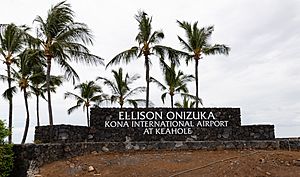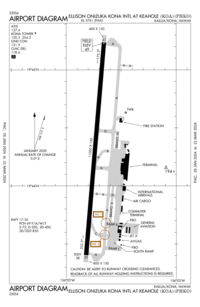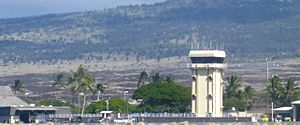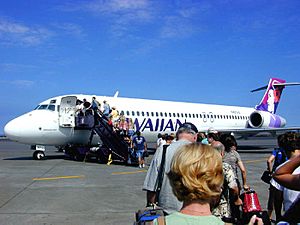Kona International Airport facts for kids
Quick facts for kids
Ellison Onizuka Kona International Airport at Keāhole
Kahua Mokulele Kauʻāina o Kona
|
|||||||||||
|---|---|---|---|---|---|---|---|---|---|---|---|
 |
|||||||||||
| Summary | |||||||||||
| Airport type | Public | ||||||||||
| Owner/Operator | Hawaii Department of Transportation | ||||||||||
| Serves | Island of Hawaii | ||||||||||
| Location | Kalaoa, Hawaii | ||||||||||
| Hub for | Mokulele Airlines | ||||||||||
| Elevation AMSL | 47 ft / 14 m | ||||||||||
| Coordinates | 19°44′20″N 156°02′44″W / 19.73889°N 156.04556°W | ||||||||||
| Map | |||||||||||
 FAA airport diagram |
|||||||||||
| Runway | |||||||||||
|
|||||||||||
| Statistics (2024) | |||||||||||
|
|||||||||||
|
Source: Federal Aviation Administration, Department of Transportation Hawaii
|
|||||||||||
Ellison Onizuka Kona International Airport at Keāhole is the main airport on the Island of Hawaiʻi. It is located in the Kailua-Kona area of Hawaii, United States. This airport serves the western side of Hawaiʻi island, including popular resort areas. It is one of two international airports on the island. The other is Hilo International Airport on the eastern side.
This airport is an important part of the Federal Aviation Administration's plan for airports. It is considered a "small-hub primary commercial service facility." This means it handles a good number of commercial flights.
Contents
History of the Airport
How the Airport Was Built
A large part of the airport's runway is built on a lava flow from the year 1801. This lava flow came from the Hualālai volcano. It added about 1 mile (1.6 km) of new land to the island. This new land created Keahole Point. The airport officially opened on July 1, 1970. It had one runway that was 6,500 feet (1,981 meters) long. The older, smaller airstrip nearby became a state park.
Construction workers used a lot of dynamite to flatten the lava rock. They finished building the airport in just 13 months. In its first full year, over 500,000 passengers used the airport.
How the Airport Got Its Name
The airport has had a few different names over the years.
When it first opened in 1970, it was called Ke-āhole Airport. This name came from its location, Keahole Point. The point itself was named after the ʻāhole fish found in the area.
In 1993, the airport's name changed to Keāhole-Kona International Airport. This added the name of the nearby town, Kona. Then, in 1997, the name was changed again to Kona International Airport at Keāhole. This put more focus on the Kona name.
On January 8, 2017, the airport was renamed Ellison Onizuka Kona International Airport at Keāhole. This was done to honor astronaut Ellison Onizuka. He was born and grew up in Kona. He sadly passed away in the Space Shuttle Challenger disaster.
How the Airport Changed Tourism
Before this new airport was built in 1970, most tourists went to Hilo. Hilo is on the eastern side of the Big Island. Tourists visiting Kona had to fly into Hilo and then drive almost two hours across the island. This became a problem as big resorts started opening in Kona around 1968.
When the Kona airport opened, it helped tourism move from East Hawaii to West Hawaii. Tourism in Hilo had already been affected by a tsunami in 1960. That event destroyed all the hotels along the coast.
The airport's impact on tourism was huge. By 2005, about 86% of all hotels on the island were on the west side. Only a few small hotels remained on the east side. Tourism has also helped the population of Hawaii County grow. Between 1990 and 2010, the number of people living there increased by 48%.
Airport Growth and Changes
In the early 1970s, Aloha Airlines and Hawaiian Airlines were the main carriers. They flew between Kona and other Hawaiian islands like Oahu, Maui, and Kauai. Aloha used Boeing 737-200 jets, and Hawaiian used McDonnell Douglas DC-9-30 jets.
By 1985, United Airlines was flying directly to Kona from Los Angeles and San Francisco. They used Douglas DC-8-71 and larger McDonnell Douglas DC-10 planes.
In 1991, a small museum opened at the airport. It was called the Astronaut Ellison S. Onizuka Space Center. It had interesting items like a sample of moon soil and a spacesuit.
In 1994, the airport's runway was made longer. It became 11,000 feet (3,353 meters) long. This made it the second-longest runway in the Hawaiian Islands. Only Honolulu's airport had a longer one. The longer runway meant much bigger planes could use the airport. This allowed direct flights between Kona and Tokyo, Japan, and other cities in the United States.
Japan Airlines (JAL) started a Kona-Tokyo flight in 1996. This route was stopped for a while but restarted in September 2017. Hawaiian Airlines also began nonstop flights from Kona to Tokyo's Haneda Airport in December 2016. Both Tokyo services were paused during the COVID-19 pandemic. During this time, a new international arrivals building was constructed. JAL restarted its Tokyo-Kona route in August 2022.
A big project started in March 2017 to update the airport. The goal was to connect the two separate terminal areas into one. This project allowed the airport to have one main security area. It also let passengers use shops and restaurants in both parts of the terminal. The Onizuka Space Center closed in March 2016 to make way for this expansion. The airport was renamed after Onizuka in January 2017.
Airport Features and Planes

Ellison Onizuka Kona International Airport at Keāhole is about 7 miles (11 km) from Kailua-Kona town. The airport covers a large area of 4,204 acres (1,701 hectares). It is 47 feet (14 meters) above sea level. It has one asphalt runway, called 17/35. It is 11,000 feet (3,353 meters) long and 150 feet (46 meters) wide. However, it is temporarily shorter, at 7,000 feet (2,134 meters), until October 1, 2025, for repairs.
In the year ending November 30, 2021, the airport had 87,770 aircraft movements. This means about 240 planes took off or landed each day. Most of these were general aviation flights. In March 2022, 56 aircraft were based at this airport. These included single-engine planes, multi-engine planes, helicopters, and ultralights.
Passenger Terminal Information
The airport is run by the State of Hawaii Department of Transportation. It has a runway and a group of single-story buildings. These buildings handle passengers, cargo, mail, and airport support.
The passenger area has open-air, tropical-style buildings. It is divided into three terminals. Terminal 1 has gates 1 to 5. Terminal 2 has gates 6 to 10. Terminal 3 is for smaller commuter flights. Kona International is the only major airport in Hawaii where passengers still use mobile stairs or ramps to board planes. They do not use modern jet bridges. Even without jet bridges, large planes use Kona. These include the Airbus A321 and A330. Boeing planes like the 717, 737, 757, 767, 777, and 787 also fly here.
Airlines and Destinations
Passenger Flights
| Airlines | Destinations |
|---|---|
| Air Canada | Seasonal: Vancouver |
| Alaska Airlines | Los Angeles, Portland (OR), San Diego, San Francisco, San Jose (CA), Seattle/Tacoma Seasonal: Anchorage |
| American Airlines | Los Angeles, Phoenix–Sky Harbor Seasonal: Dallas/Fort Worth |
| Delta Air Lines | Los Angeles, Seattle/Tacoma Seasonal: Salt Lake City (begins December 19, 2025) |
| Hawaiian Airlines | Honolulu, Kahului, Lihue, Sacramento |
| Mokulele Airlines | Kahului, Waimea |
| Southwest Airlines | Honolulu, Kahului, Las Vegas, Sacramento Seasonal: Los Angeles |
| United Airlines | Denver, Los Angeles, San Francisco Seasonal: Chicago–O'Hare |
| WestJet | Seasonal: Calgary, Vancouver |
Cargo Flights
| Airlines | Destinations |
|---|---|
| Aloha Air Cargo | Hilo, Honolulu, Kahului |
| Amazon Air | Riverside/March Air Base |
| Atlas Air | Kahului, Ontario |
| Kalitta Air | Los Angeles |
| UPS Airlines | Honolulu, Kahului, Ontario |
Airport Statistics
Number of Passengers
Top Airlines by Passengers
| Rank | Airline | Passengers | Share |
|---|---|---|---|
| 1 | Hawaiian Airlines | 1,563,000 | 39.45% |
| 2 | Southwest Airlines | 644,000 | 16.25% |
| 3 | United Airlines | 633,000 | 15.97% |
| 4 | Alaska Airlines | 615,000 | 15.52% |
| 5 | American Airlines | 256,000 | 6.46% |
| 6 | Other | 252,000 | 6.35% |
This table shows which airlines carried the most passengers to and from Kona Airport between March 2024 and February 2025. Hawaiian Airlines carried the most people.
Most Popular Destinations
| Rank | City | Passengers | Carriers |
|---|---|---|---|
| 1 | Honolulu, Hawaii | 725,490 | Hawaiian, Southwest |
| 2 | Los Angeles, California | 267,180 | American, Delta, Hawaiian, Southwest, United |
| 3 | Seattle/Tacoma, Washington | 214,510 | Alaska, Delta |
| 4 | Kahului, Hawaii | 147,280 | Hawaiian, Mokulele, Southwest |
| 5 | San Francisco, California | 135,480 | United |
| 6 | Denver, Colorado | 98,570 | United |
| 7 | Phoenix, Arizona | 70,330 | American |
| 8 | Oakland, California | 57,760 | Southwest |
| 9 | Las Vegas, Nevada | 57,600 | Southwest |
| 10 | San Diego, California | 47,110 | Alaska |
This table lists the cities that had the most flights to and from Kona Airport. Honolulu, Hawaii, is the busiest route.
Airport Events
- On August 25, 1977, a small cargo plane crashed while trying to land at the airport. The pilot and passenger did not survive.
- On September 10, 1989, a pilot had to make an emergency landing due to engine trouble. The plane crashed near the runway, resulting in one person passing away and another being seriously hurt.
- On June 21, 2022, a plane had a problem with its landing gear. This blocked the runway for three hours, and some incoming flights had to go to other airports. The pilot was not injured.
- On January 16, 2024, cracks were found in the runway. The airport had to close temporarily for repairs. It reopened the next morning.
See also
 In Spanish: Aeropuerto Internacional de Kona para niños
In Spanish: Aeropuerto Internacional de Kona para niños
- List of airports in Hawaii


